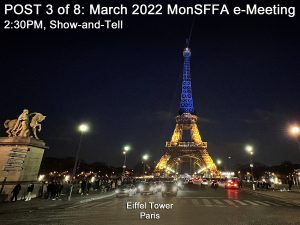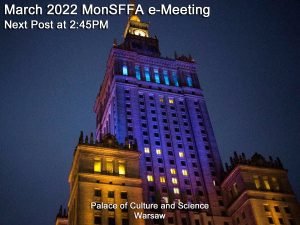6) SHOW-AND-TELL
Exclusively on Zoom, we open the floor for the next 15 minutes to club members who have “fancraft” projects to showcase.
 For folk not on Zoom with us, today, we take this opportunity to remind you of our ongoing Writing Challenge, launched last month. Here, again, is what we outlined during February’s e-meeting:
For folk not on Zoom with us, today, we take this opportunity to remind you of our ongoing Writing Challenge, launched last month. Here, again, is what we outlined during February’s e-meeting:
Barring the emergence of another dangerous variant, Public Health restrictions will finally be lifted for good at some point soon, and with most of us having been largely relegated to our homes for almost two years, now, we’ll be itching to travel as winter recedes and with it, we hope, COVID-19. Below are listed a dozen possible Canadian destinations for your consideration, singular, curious, unusual, and otherworldly places likely to appeal in some way to SF/F fans.
We’ve added a little something extra, too, to the mix, here, in the form of a writing challenge to occupy you during the remaining weeks of winter. We’re looking for original short stories or works of fan-fiction, between roughly a thousand and three thousand words—science fiction, fantasy, or horror; your choice! With the weird and wonderful destinations below, we hope to inspire you to author a fantastic, fanciful, frightening, or funny tale. Each entry includes a story prompt designed to get your creative juices flowing, but feel free to ignore our suggestions and go your way.
So have fun with it, and we look forward to reading your stories in a future issue of Warp!
And here are those Canadian otherworldly sites and attractions, and story prompts, as presented last month:
Devon Island and the Haughton Impact Crater, Nunavut
Devon Island is the world’s largest uninhabited island and part of the Canadian Arctic Archipelago. It is located in Baffin Bay north of Baffin Island. So otherworldly is Devon Island’s landscape that the Mars Society there established the Flashline Mars Arctic Research Station in order that scientists may simulate missions to the Red Planet.
Formed some 39 million years ago when a meteor about two kilometers in diameter slammed into what was then a forest, the Haughton Impact Crater adjacent the station is considered the best Mars analog on Earth. NASA’s complementary Haughton-Mars Project is also in operation at the crater during the summer months.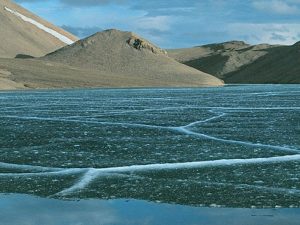
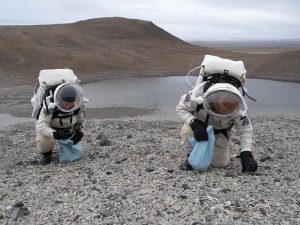
This landscape may well inspire a science fiction story about a mission to Mars, or another planet having a similarly hostile environment. What might the explorers from Earth find there, and what perils might they face?
The Cheltenham Badlands, Caledon, Ontario
Situated between the villages of Inglewood and Cheltenham in the primarily rural municipality of Caledon, the Cheltenham Badlands are an exposed and greatly eroded section of the Queenston Formation, which formed during the mid- and late-Ordovician Period, between roughly 470 and 443 million years ago. Characterized by rounded hills and gullies, this terrain is composed chiefly of brick-red shale, interlaced with layers of green shale, sandstone, and limestone. Representing probably the best example of badlands topography in Ontario, the area easily suggests the strange landscape of an alien world on which a tale of the far-flung future might be set.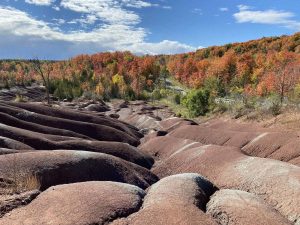
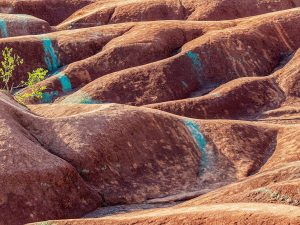
The story could begin with the crash-landing of a spaceship on this world and detail the efforts of the crew to survive until a rescue mission arrives from distant Earth. Having salvaged from their wrecked craft what equipment and stores were not irreparably damaged or destroyed in the crash, they are faced with a dearth of vital supplies. Their first priority is to locate a source of water and find a way to farm the harsh soil, perhaps employing vegetable scraps and seeds derived from their remaining onboard food supply to cultivate fresh and progressively more produce. They spy in the distance a herd of large, centipede-like animals foraging on the scant indigenous flora. These beasts may well offer a supply of protein-rich meat.
But there’s something else out there, amid the knolls and furrows; something primordial and predatory, lying in wait, still and patient, the natural colouring and texture of its skin perfect camouflage for these surroundings, rendering the enormous, snake-like creature effectively invisible—until it moves to strike!
Hopewell Rocks, Hopewell Cape, New Brunswick
The Hopewell Rocks, also called the Flowerpot Rocks, are the principal tourist attraction of the village of Hopewell Cape on Shepody Bay, part of the greater Bay of Fundy. A geological formation composed largely of dark sedimentary conglomerate and sandstone, the Rocks have been eroded by the famous Fundy tides. With glacial retreat after the Ice Age, surface water seeping through cracks in the shoreline bluffs, over time, separated the Rocks from the cliff face. Further, tidal waters, rising—by up to 16 metres—and falling twice a day, have worn down this collection of towering pillars, most acutely at their base. Visitors are able to descend to the beach at low tide for a closer look.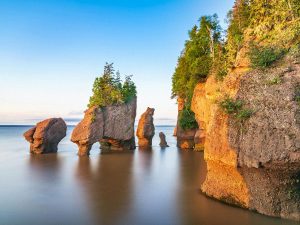
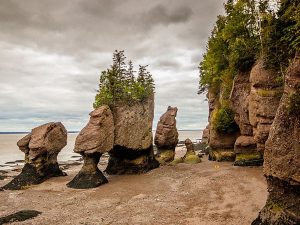
A fantasy story is evoked by this landscape, perhaps involving a local fisherman assisting a beautiful mermaid who has come ashore one morning to escape a ravenous sea serpent. Not a one of his family or friends believe his yarn, of course, known as he is for spinning such tall tales over a pint or two!
The Crooked Bush, Alticane, Saskatchewan
Also called the “Twisted Trees” or the “Crooked Tress of Alticane,” this copse of hideously deformed aspens can be found near the abandoned village of Alticane, Saskatchewan, today considered a ghost town. Prominent in the province’s folklore, the existence of the trees is sometimes attributed to paranormal forces.
Genetic mutation is offered as the scientific explanation for this botanical anomaly, the aberration likely originating with a single tree as aspen’s propagate through a shared root system to form large, clonal groves. A cordon surrounds the warped thicket for purposes of protection, and to contain any further spread of the malformation to other, bordering aspens, which stand straight and tall.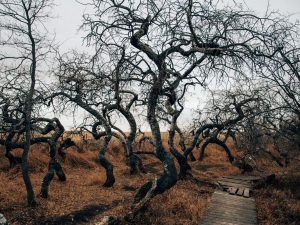
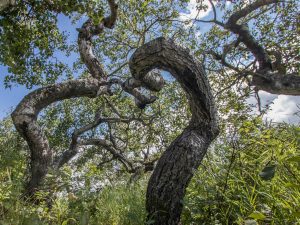
A Lovercraftian horror story, perhaps, may emerge from the fevered dream provoked simply by having gained knowledge of these accursed aspens, for one can scarcely comprehend what blasphemous monstrosity long ago may have marred this small patch of wood, leaving trunks and branches gnarled and bent. Ever are these blighted trees a reminder to the multitude and variety of life which teems over this inconsequential globe of the paltry place we denizens of planet Earth hold within a universe ravaged by outrages evil, dark, and unimaginable!
Le Grand rassemblement, Sainte-Flavie, Québec
On a rock-strewn beach overlooking the St. Lawrence River stand some hundred strange stone and wooden figures, arrayed so as to appear a column of people wading ashore. The creation of Quebec artist Marcel Gagnon, these figures are simple in design, carved heads atop a post or pillar, some hunched, exuding a haunting quality, all worn by the weather and tides, those farthest out on the beach disappearing and reappearing with the ebb and flow of the great river.
The artist initially began carving the effigies as figure studies for his vivid impressionistic paintings but eventually repurposed them as an art installation, which can be viewed at his Centre d’Art Marcel Gagnon in Ste-Flavie, a small town on the Gaspé Peninsula.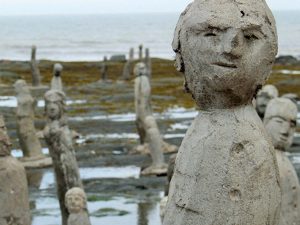
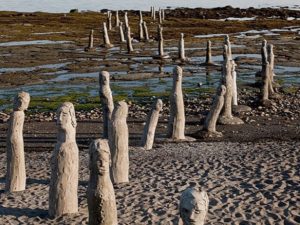
Some kind of ghost story, perhaps, or dark fantasy involving a curse long ago cast upon the local townspeople suggests itself, here.
The Enchanted Forest, Revelstoke, British Columbia
A family-friendly roadside attraction in the Monashee Mountains some 30 kilometres west of Revelstoke, The Enchanted Forest places over 350 kitschy, handcrafted figurines of faerie folk and storybook characters amongst the towering cedars of an old-growth forest. The roster includes Snow White and the Seven Dwarves, Goldilocks and the Three Bears, the Three Little Pigs, Winnie-the-Pooh and Friends, Humpty Dumpty, the Old Woman Who Lived in a Shoe, the Tooth Faerie, the Pied Piper, along with mermaids, gnomes, a dragon, and many more!
Folk-art sculptor Doris Needham and her husband, Ernest, built the attraction largely by hand as a retirement project, opening their wonderland to the public on July 1, 1960. The Enchanted Forest has since expanded to encompass eight acres of fun for the whole family.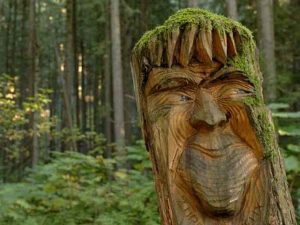
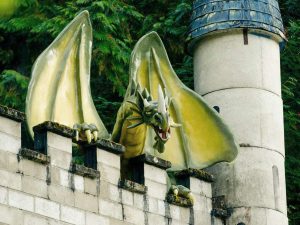
Faerie folk and the like can make for an inviting fantasy tale, maybe involving the many characters, here, magically coming to life so as to uplift the spirits of a traumatized and forlorn child.
UFO Landing Pad, St. Paul, Alberta
The east-central Alberta town of St. Paul built the world’s first UFO landing pad in 1967 as part of Canada’s nationwide Centennial Celebrations. Paul Hellyer, then Canada’s defense minister, flew in by helicopter to officially inaugurate the structure.
A plaque put up beside the pad reads:
The area under the World’s First UFO Landing Pad was designated international by the Town of St. Paul as a symbol of our faith that mankind will maintain the outer universe free from national wars and strife. That future travel in space will be safe for all intergalactic beings, all visitors from earth or otherwise are welcome to this territory and to the Town of St. Paul.
Hellyer, who died last year at age 98, publicly announced in 2005 that he believed in the existence of extraterrestrials, that he and his wife had once seen a UFO, and that at least four species of aliens from other star systems have been visiting Earth for thousands of years, some of them now based on Mars, Venus, and the moons of Saturn! He also urged governments around the world to help solve the global climate crisis by employing the alien technology they have secreted away all these years.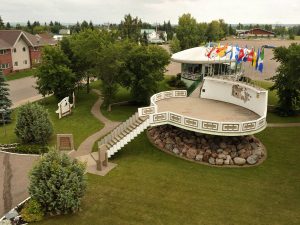
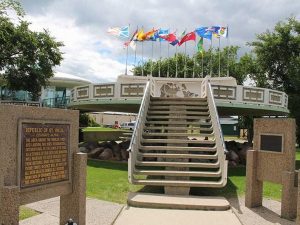
So what if a UFO actually touched down in St. Paul one day? What would be the reaction of local, national, and foreign governments, the military, the scientific community, religious leaders, and the ordinary people of the town? And would the extraterrestrials share the sentiments inscribed on that plaque?
The Moonbeam Flying Saucer, Moonbeam, Ontario
Speaking of UFOs, the small northern Ontario town of Moonbeam has erected a flying saucer monument next to the town’s visitor centre. With the National Transcontinental Railway providing access to the agricultural land and natural resources of the environs, the town was founded and settled by Quebecers from the Laurentians and Montreal in the early 1910s and ’20s. French is spoken by almost 80 percent of townspeople.
The slogan “Where the moonbeams blend in with the Northern Lights” is used to promote tourism and while no documentation exists as confirmation, the town’s name is attributed to early pioneers who often reported flashing lights falling from the sky near area creeks and ponds. They called these mysterious lights “moonbeams.” That’s a potential sci-fi story right there!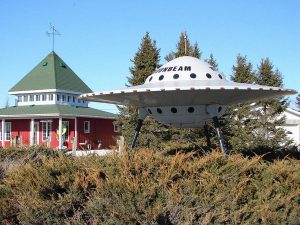
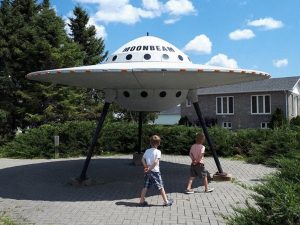
Spotted Lake, Osoyoos, British Columbia
Northwest of the Okanagan town of Osoyoos in B.C.’s Similkameen Valley, the endorheic Spotted Lake, rich in salt and various minerals, was historically and is still revered by the territory’s First Nations people as a sacred site thought to proffer therapeutic waters.
In the summer, evaporation exposes concentrated deposits of calcium, magnesium sulfate, and other elements and compounds, which, combined with seasonal precipitation, form small, colourful pools of water, lending the lake its distinctive spots. Also formed around and between these spots are natural hardened-mineral pathways.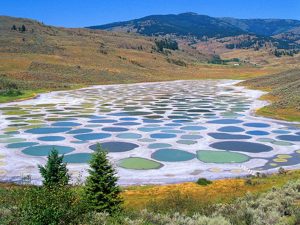
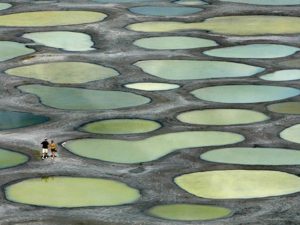
A medieval fantasy story could be conjured up around such a lake, the waters of which an evil sorceress might exploit to brew her magical potions.
Abraham Lake, Kootenay Plains, Alberta
When the Bighorn Dam was built in 1972, a sizeable tract of land was flooded to create Abraham Lake, Alberta’s largest reservoir, situated on the North Saskatchewan River in the Kootenay Plains area of the Canadian Rocky Mountains. Tourists and nature photographers are drawn to the site by a bizarre phenomenon.
Rotting vegetation at the bottom of the lake releases methane gas which coalesces into bubbles that, in winter, become trapped in ice as they rise towards the surface, creating weirdly beautiful columns of globules beneath the frozen lake surface.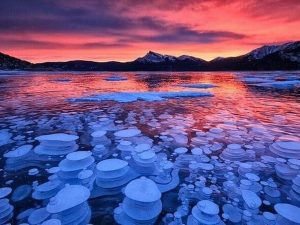
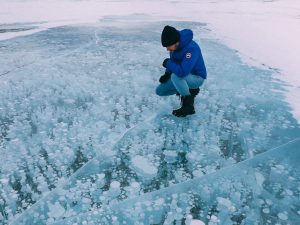
Consider a story that serves as an allegory for climate change: on an icy planet or moon in some distant solar system, perhaps a similar wonder occurs, and maybe within each ice-encased pocket of gas thrives a completely alien civilization populated by exotic miniature beings! But what would happen to those beings if that frozen world began to warm?
Bear Rock and the Bear Rock Sinkhole, Sahtu Region, Northwest Territories
The Sahtu Region includes Bear Rock, an outcropping considered hallowed ground by the Dene people. It is said that in ancient days, when giants roamed the Earth, fabled Dene law-giver Yamoria slew a trio of enormous beavers that had been drowning hunters, and that Bear Rock was the mountain over which he draped their gargantuan pelts, leaving the dark, reddish stains which distinguish the rock to this day—a bit of Beavra fan-fiction can certainly spring out of all of that!
Characterized by underground waterways and the gradual dissolution of soluble rock like limestone and dolomite, the karst landforms of Bear Rock and the vast surrounding domain include numerous pinnacles, poljes, turloughs, caves, and sinkholes.
Of the many sinkholes pitting this pristine and remote wilderness, the largest and most remarkable is the Bear Rock Sinkhole, likely the result of a cave-in and one of North America’s finest examples of a vertical cover-collapse event. Inaccessible by road or trail, the ovate Bear Rock Sinkhole lies between the towns of Tulita and Norman Wells and is roughly the length and width of a football field, its vertical walls plunging some 40 metres to the pool of cerulean blue water below.
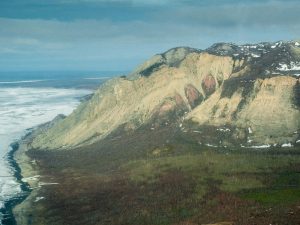
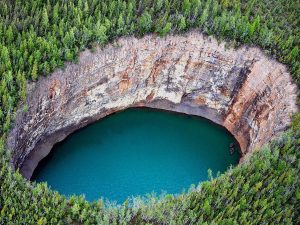
But what if beneath the surface of that water was discovered a portal to the past, or to another dimension? Or, if supernatural satanic horror is your groove, a portal to hell?
Akshayuk Pass, Baffin Island, Nunavut
Appropriately dubbed Land of the Gods, Akshayuk Pass is an ancient river bed and traditional Inuit travel corridor bordered by towering granite peaks, among them imposing Mount Odin, arrowhead-shaped Mount Loki, and other summits the names of which derive from Norse mythology—though unverified, it is believed that the earliest European exploration of the region was by Norse adventurers in the 11th century. The area, today within Canada’s Auyuittuq National Park in northeastern Baffin Island, draws first-class mountaineers from around the world.
Of note is Thor Peak, also called Mount Thor, dramatically thrusting skyward, a sheer precipice, offering rock climbers one of the world’s highest vertical drops! The spectacular vista surrounding Thor inspires a fantastical winter realm populated by Ijirait (shape-shifters), Chenoos (cannibalistic ice giants), the Qiqirn (a dog spirit), and other mythological creatures of the north to be found in aboriginal legend. One imagines a hero embarking on a precarious trek to the mountain in search of his or her destiny.
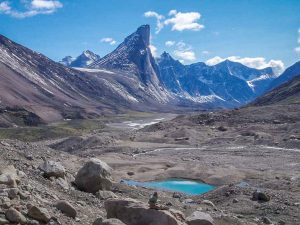
If a work of fan-fiction is your fancy, meanwhile, Mount Asgard is a twin-towered, flat-topped mountain of the type suitable for hollowing out by a Bond villain as his secret lair, or by the Rebel Alliance as a hidden base.
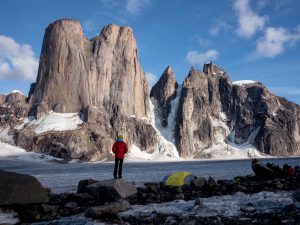
So with the starter pistol having been fired on this writing challenge, time to get going on your stories if you haven’t already!

